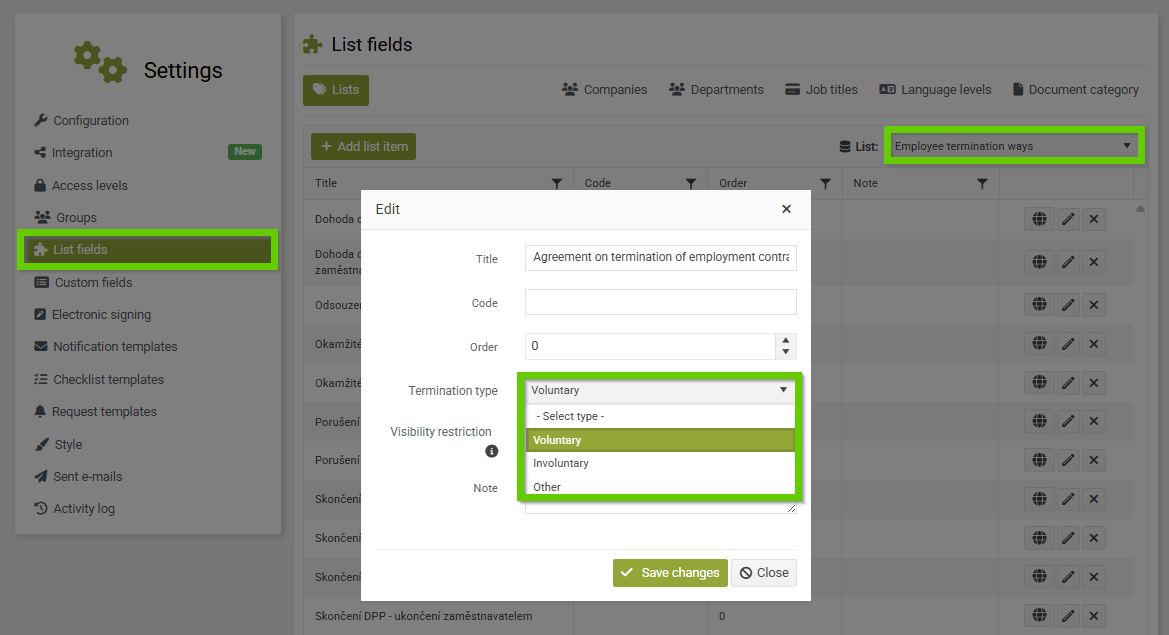Records of voluntary employee departures
Why monitor the voluntariness of departure?
Distinguishing between voluntary and involuntary departures is one of the basic HR metrics.
- Voluntary departures (e.g., employee resignation, departure for a better offer, relocation) indicate the level of employee satisfaction and loyalty. If their number is increasing, it may signal problems with remuneration, atmosphere, or development opportunities.
- Involuntary departures (e.g. termination by the employer, termination due to redundancy, breach of discipline) are primarily related to employee performance and organizational changes.
- Other reasons (e.g. death of an employee) need to be recorded separately to avoid distorting statistics.
Thanks to this breakdown, you can monitor not only overall turnover, but also its causes and the trend in employee satisfaction.
Three attributes related to leaving
Three linked attributes are implemented in the system:
- Method of leaving (HOW he left) – e.g. Termination by the employee, Agreement on termination of employment contract, Cancellation during the probationary period…
- Reason for leaving (WHY left) – e.g. Change of residence, Better job offer, Dissatisfaction with employer, Retirement…
- Type of departure (VOLUNTARY/INVOLUNTARY/Other) – clearly determines whether the employee left of their own free will, by decision of the employer, or for another reason.
Recommended dial settings
Method of departure and determination of voluntariness of departure
The exit method is a user dialpad, manage it in Settings > Dialpad entries .
Voluntariness of departure is determined by the Departure type attribute, which is part of the Departure method code list; its values are system values and cannot be changed by the user .

To make the outputs consistent and comparable, we recommend setting the values in the Exit Method code list with the assigned Exit Type according to the following table:
Way of leaving | Departure type |
Agreement on termination of employment contract - by the employee | Voluntary |
Agreement on termination of employment contract - from the employer | Involuntary |
Cancellation during the probationary period - by the employee | Voluntary |
Termination during the probationary period - by the employer | Involuntary |
Termination – employer terminates employee | Involuntary |
Cancellation – redundancy | Involuntary |
Cancellation – medical incapacity | Involuntary |
Cancellation – does not meet the requirements | Involuntary |
Breach of duty (less serious) | Involuntary |
Breach of obligations (repeatedly) | Involuntary |
Serious violation (gross breach of discipline) | Involuntary |
Sentence to imprisonment | Involuntary |
Loss of work authorization | Involuntary |
Immediate cancellation by employee | Voluntary |
Immediate cancellation by the employer | Involuntary |
Expiration of a fixed term - termination by the employee | Voluntary |
Expiration of a fixed term - termination by the employer | Involuntary |
Termination by an employee | Voluntary |
Termination by employer | Involuntary |
Termination of the employment contract - termination by the employee | Voluntary |
Termination of DPC - termination by the employer | Involuntary |
Termination of DPP - termination by employee | Voluntary |
Termination of DPP - termination by employer | Involuntary |
Death of an employee | Other |
Reason for leaving
- is a user dialpad, manage in Settings > Dialpad entries.
For the Reason for Leaving code field, we recommend using the following set of values:
- Change of residence / relocation
- Family/child care
- Studying/Back to school
- Health reasons (personal)
- Retirement
- Better job offer / higher salary
- Career growth/professional challenge
- Underutilization of competencies / dissatisfaction with the role
- Lack of development and education
- Bad atmosphere in the team
- Dissatisfaction with employer
- Insufficient work/life balance
- Redundancy/reorganization
- Ending a project/role
- Mergers/Acquisitions
- Change of strategy / cost optimization
- Insufficient work performance
- Violation of work discipline
- Failure to meet competency requirements
- Repeated absences/reliability
- Death of an employee
- Long-term disability
- He did not start work.
Benefit for analytics and reporting
Thanks to the combination of these attributes:
- You will get an overview of the total fluctuation and its distribution (voluntary × involuntary).
- You can track the main reasons for voluntary departures and aim to reduce them.
- You can evaluate the effectiveness of HR measures - for example, whether the number of departures decreased after changing benefits due to a better offer.
- The outputs will be comparable across the company and over time, because the records are based on standardized code lists.
